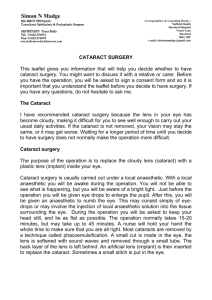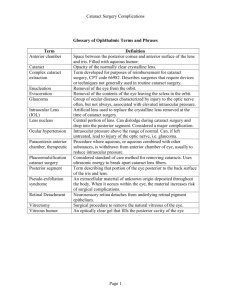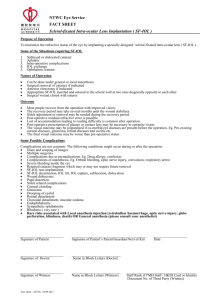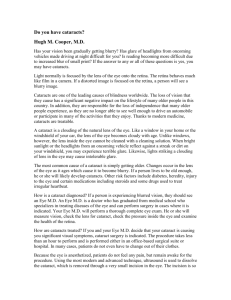Cataract Surgery - Curtis (Opticians)
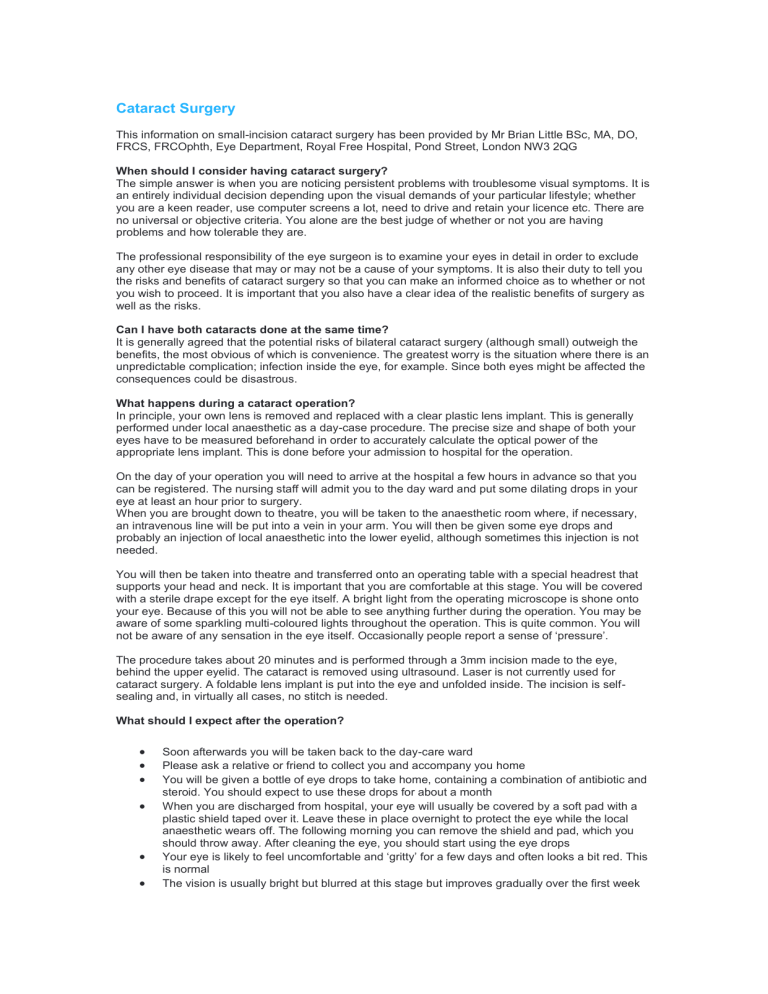
Cataract Surgery
This information on small-incision cataract surgery has been provided by Mr Brian Little BSc, MA, DO,
FRCS, FRCOphth, Eye Department, Royal Free Hospital, Pond Street, London NW3 2QG
When should I consider having cataract surgery?
The simple answer is when you are noticing persistent problems with troublesome visual symptoms. It is an entirely individual decision depending upon the visual demands of your particular lifestyle; whether you are a keen reader, use computer screens a lot, need to drive and retain your licence etc. There are no universal or objective criteria. You alone are the best judge of whether or not you are having problems and how tolerable they are.
The professional responsibility of the eye surgeon is to examine your eyes in detail in order to exclude any other eye disease that may or may not be a cause of your symptoms. It is also their duty to tell you the risks and benefits of cataract surgery so that you can make an informed choice as to whether or not you wish to proceed. It is important that you also have a clear idea of the realistic benefits of surgery as well as the risks.
Can I have both cataracts done at the same time?
It is generally agreed that the potential risks of bilateral cataract surgery (although small) outweigh the benefits, the most obvious of which is convenience. The greatest worry is the situation where there is an unpredictable complication; infection inside the eye, for example. Since both eyes might be affected the consequences could be disastrous.
What happens during a cataract operation?
In principle, your own lens is removed and replaced with a clear plastic lens implant. This is generally performed under local anaesthetic as a day-case procedure. The precise size and shape of both your eyes have to be measured beforehand in order to accurately calculate the optical power of the appropriate lens implant. This is done before your admission to hospital for the operation.
On the day of your operation you will need to arrive at the hospital a few hours in advance so that you can be registered. The nursing staff will admit you to the day ward and put some dilating drops in your eye at least an hour prior to surgery.
When you are brought down to theatre, you will be taken to the anaesthetic room where, if necessary, an intravenous line will be put into a vein in your arm. You will then be given some eye drops and probably an injection of local anaesthetic into the lower eyelid, although sometimes this injection is not needed.
You will then be taken into theatre and transferred onto an operating table with a special headrest that supports your head and neck. It is important that you are comfortable at this stage. You will be covered with a sterile drape except for the eye itself. A bright light from the operating microscope is shone onto your eye. Because of this you will not be able to see anything further during the operation. You may be aware of some sparkling multi-coloured lights throughout the operation. This is quite common. You will not be aware of any sensation in the eye itself. Occasionally people report a sense of ‘pressure’.
The procedure takes about 20 minutes and is performed through a 3mm incision made to the eye, behind the upper eyelid. The cataract is removed using ultrasound. Laser is not currently used for cataract surgery. A foldable lens implant is put into the eye and unfolded inside. The incision is selfsealing and, in virtually all cases, no stitch is needed.
What should I expect after the operation?
Soon afterwards you will be taken back to the day-care ward
Please ask a relative or friend to collect you and accompany you home
You will be given a bottle of eye drops to take home, containing a combination of antibiotic and steroid. You should expect to use these drops for about a month
When you are discharged from hospital, your eye will usually be covered by a soft pad with a plastic shield taped over it. Leave these in place overnight to protect the eye while the local anaesthetic wears off. The following morning you can remove the shield and pad, which you should throw away. After cleaning the eye, you should start using the eye drops
Your eye is likely to feel uncomfortable and ‘gritty’ for a few days and often looks a bit red. This is normal
The vision is usually bright but blurred at this stage but improves gradually over the first week
The important point to emphasise is that you can resume your normal daily activities straight away and there is no need for any restrictions
Your glasses will need to be changed by your optometrist. This can be done at a minimum of three weeks after surgery, by which time the eye has fully recovered
What are the risks and complications of cataract surgery?
Cataract surgery has become one of today's most successful operations. If you have nothing else wrong with your eye other than the cataract, you have about a 95% chance of obtaining normal vision with your new glasses.
However, no operation is without complications. Overall, about 7% of patients experience a documented event during the operation. The commonest of these is rupture of the delicate lens capsule. This may prevent the insertion of a lens implant and increases the chance of further complications such as glaucoma and retinal detachment.
The risk of all other complications during surgery is below 1%.
Post-operatively, sight-threatening complications of cataract surgery are rare. Infection inside the eye
(endophthalmitis) occurs in approximately 1 in 1,000 operations. Retinal detachment occurs at around the same frequency.
Minor complications occur more commonly but do not affect the final result. These include temporary cloudiness of the cornea (the clear window at the front of the eye) which happens 10% of the time, raised pressure in the eye that occurs after 8% of operations, and inflammation inside the eye that happens in 5% of cases. Together these account for the vast majority of minor complications and are very rarely of any consequence.
Are there any long-term complications?
A process that occurs almost always following cataract surgery, to a greater or lesser degree, is opacification of the posterior lens capsule - scarring of the membrane that supports the lens implant.
This appears to be less common with modern types of lens implants but in 20-50% of cases it progresses to a degree that impairs vision. It occurs between six months and five years following cataract surgery and requires laser treatment if it produces visual symptoms. It is more common in children, young adults and those with diabetic retinopathy or inflammation inside the eye. As with any procedure there are associated risks but complications are rare. There is a small risk (less than 1%) of subsequent retinal detachment , dislocation of the lens implant or swelling of the retina.
Summary
Modern small incision cataract surgery is a very successful operation with an excellent outcome in over nine out of ten cases
The risk of complications is low, and sight-threatening complications are rare
Most operations are carried out under local anaesthetic as a day-case procedure
You can return to your normal daily activities straight away; there are no restrictions
The eye will feel gritty and uncomfortable for a few days but should not be painful
Visual recovery takes place for most people over the first week or two
You will be using eye drops for about a month
You will need to replace your glasses with a new prescription once the drops are finished.
